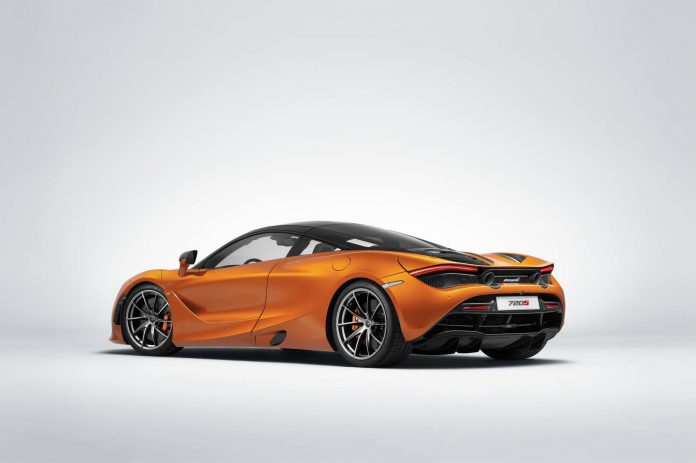McLaren have officially taken the covers off the McLaren 720S, the replacement model for the Super Series McLaren’s, at the Geneva Motor Show 2017. It is probably the biggest release at the Geneva show this year and does not disappoint! McLaren will be hoping that it builds upon the hugely successful 650S model it replaces.
The McLaren 720S is a completely new animal. It heralds in a new design language for McLaren. The body panels are mostly aluminium, wrapped around the carbon fibre structure. It looks delicate and futuristic yet manages to retain familiar elements of McLaren’s previous models. The side profile has a clear teardrop shape to it with slim windscreen pillars and a complete panoramic glasshouse feeling. It should feel light inside with plenty of visibility.
One crucial aspect is the conspicuous absence of radiator intakes on the side. McLaren have designed a unique double skin to the dihedral doors which channels air into the radiators. Cooling is actually improved by 15% over the 650S. The front bumper features digital LED headlights integrated within aerodynamic ‘eye-sockets’ which channel air to the low-temperature radiators. The headlights incorporate Static Adaptive Headlight technology with five LED’s producing the base, static beam pattern and the remaining 12 operating in accordance with the direction the front of the car is moving.
Much work has been carried out to repackage the Super Series. The top of the V8 engine is mounted 120 mm lower than the 12C. The rear is some 145mm lower overall. The lowered radiator header tank, repositioned structural airboxes and the introduction of a central high-mounted top light all help increase visibility while lowering centre of gravity. The added benefit is the ability to tightly pack the car for improved aerodynamic efficiency.
The aerofoil-profile rear wing delivers up to 30% more downforce. It has three hydraulically operated positions as well as airbrake functionality. Driver downforce gives 70% to 80% wing deployment, DRS which gives 30% wing deployment and High Speed Braking with 100% airbrake deployment in less than 0.5sec.
The McLaren 720S retains the mid-engined, rear-wheel drive layout of the 650S. Aside from this crucial similarity, everything else is new. The McLaren 720S gets a brand new carbon fibre chassis based around the Monocage II structure. Constructed entirely from carbon fibre, the tub is both light weight and strong. Select body panels and chassis components are constructed from aluminium alloys.
Dry weight is now 1,283kg compared to the 650S’ 1,301 kg. The electrical system is 3kg lighter, the braking system saves 2kg and the structural airboxes save 1.5kg. The new suspension system also delivers a 16kg weight saving. There is a new generation of McLaren’s active chassis system, Proactive Chassis Control II. The familiar Comfort, Sport, or Track modes are retained for both the drivetrain and the chassis.
Crucially, the McLaren 720S debuts a new, M480T twin-turbocharged 4.0-litre V8 engine, rated at 720PS and 770Nm. It’s power to weight ratio is 561PS per tonne which allows for an electrifying 0-100km/h time of 2.9 seconds, a 0-200km/h time of 7.8 seconds and a top speed of 341 km/h. Braking from 200 km/h to standstill takes just 117 metres and 4.6 seconds. As with all modern supercars, efficiency has relevance. The McLaren 720 S manages 10.7 litres/100km fuel economy and 249g/km CO 2 emissions (NEDC).
McLaren have manufactured more space inside the 720S with space behind the seat backs for two soft holdalls, equivalent to 210 litres, and an addition 150 litres under the front panel. The design is simplified too with a unique Folding Driver Display and central infotainment screen running an entirely new system architecture developed with JVC KENWOOD. In full display mode, the Folding Driver Display shows the usual information on a high-definition TFT panel. At either the touch of a button the display slides down to Slim Display Mode which gives just essential information with minimum distraction.
An 8-inch display forms the central information system with audio, media, navigation and other convenience features. The McLaren Track Telemetry has been completely redesigned with more comprehensive information, G-maps, throttle position and full lap history available from the central screen. The driver and passenger sit in sports seats. There is an option for a sports steering wheel with colour-matched, carbon fibre or Alcantara.
The McLaren 720S gets the usual conveniences too with parking sensors, a reversing camera or ’birdseye’ 360-degree park assist and a Bowers & Wilkins-branded sound system with Kevlar mid-range speaker cones and carbon fibre woofer cones. Standard, Performance and Luxury trims are available with a range of ‘option packs’. Of course, if you want something truely unique, McLaren Special Operations (MSO) will help to produce this!
Exterior colour palettes consist of 20 colours, including different greys, whites, blues, and reds. Seven new colours have been developed for the 720S. Deliveries of McLaren’s new supercar will commence in May, with retail prices starting at a premium of around 5% over the 650S Coupe.
































